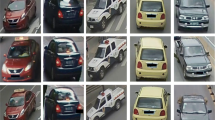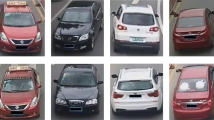Abstract
The goal of vehicle re-identification is to identify the same vehicle from multiple cameras, which is a challenging task. There are many solutions to this problem, among which the self-attention mechanism is very popular. It can capture the long-range dependence in an image, thereby suppressing the irrelevant features. Most of the existing designs are based on isolated pairwise query-key interactions to refine a node. They implicitly mine attention patterns without explicitly modeling node weights. In this paper, we propose a global relational attention mechanism, which makes full use of the global dependence of a node to learn and infer its weight value. Global dependence can measure the importance of nodes more robustly and efficiently. To capture more discriminative features, we propose a maximum suppression constraint to adaptively adjust weight values to expand the range of attention. In addition, we design a pair of effective attention modules based on the proposed attention mechanism, that focus on mining the discriminative features related to vehicle identities from the spatial and channel dimensions. We conduct a large number of experiments on the VeRi-776 and VehicleID datasets, and the experimental results demonstrate the effectiveness of our method.








Similar content being viewed by others
Data availability
All data included in this study are available upon request by contact with the corresponding author.
References
Chen B, Deng W, Hu J (2019) Mixed high-order attention network for person re-identification. In: ICCV, pp 371–381
Xu J, Zhao R, Zhu F, Wang H, Ouyang W (2018) Attention-aware compositional network for person re-identification. In: CVPR, pp 2119–2128
Fang P, Zhou J, Roy SK, Petersson L, Harandi M (2019) Bilinear attention networks for person retrieval. In: ICCV, pp 8030–8039
Zhang Z, Lan C, Zeng W, Xin J, Zhibo C (2020) Relation-aware global attention for person re-identification. In: CVPR, pp 3183–3192
Wang G, Yuan Y, Chen X, Li J, Zhou X (2018) Learning discriminative features with multiple granularities for person re-identification. In: Proceedings of the 26th ACM international conference on multimedia, October, pp 274–282
Lai S, Chai Z, Wei X (2021) Transformer meets part model: adaptive part division for person re-identification. In: ICCVW, pp 4133–4140
He S, Luo H, Wang P, Wang F, Li H, Jiang W (2021) TransReID: transformer-based object re-identification. CoRR arXiv:2102.04378
Woo S, Park J, Lee J-Y, Kweon IS (2018) Cbam: convolutional block attention module. In: ECCV, pp 3–19
Wang F, Jiang M, Qian C, Yang S, Cheng L, Zhang H, Wang X, Tang X (2017) Residual attention network for image classification. In: CVPR, pp 3156–3164
Luo W, Li Y, Urtasun R, Zemel R (2016) Understanding the effective receptive field in deep convolutional neural networks. In: NeurIPS, pp 4898–4906
Wang X, Girshick R, Gupta A, He K (2018) Non-local neural networks. In: CVPR, pp 7794–7803
Vaswani A, Shazeer N, Parmar N, Uszkoreit J, Jones L, Gomez AN, Lukasz K, Illia P (2017) Attention is all you need. In: NIPS, pp 5998–6008
Zhang G, Zhang P, Qi J, Lu H (2021) HAT: hierarchical aggregation transformers for person re-identification. In: ACM multimedia, pp 516–525
Dosovitskiy A, Beyer L, Kolesnikov A, Weissenborn D, Zhai X, Unterthiner T, Dehghani M, Minderer M, Heigold G, Gelly S et al (2020) An image is worth 16x16 words: transformers for image recognition at scale. arXiv preprint arXiv:2010.11929
Carion N, Massa F, Synnaeve G, Usunier N, Kirillov A, Zagoruyko S (2020) End-to-end object detection with transformers. In: European conference on computer vision
Wang W, Pei Y, Wang S, Gorrz JM, Zhang Y (2023) PSTCNN: explainable COVID-19 diagnosis using PSO-guided self-tuning CNN. Biocell 47(2):373–384
Wang W, Zhang X, Wang S-H, Zhang Y-D (2022) Covid-19 diagnosis by WE-SAJ. Syst Sci Control Eng 10(1):325–335
Chen S-Z, Guo C-C, Lai J-H (2016) Deep ranking for person re-identification via joint representation learning. IEEE Trans Image Process 25:2353–2367
Luo H, Gu Y, Liao X, Lai S, Wei J (2019) Bag of tricks and a strong baseline for deep person re-identification. In: CVPR workshop
Li W, Zhao R, Xiao T, Xiaogang W (2014) Deep filter pairing neural network for person reidentification. In: CVPR, Deepreid
Li W, Zhu X, Gong S (2017) Person reidentification by deep joint learning of multi-loss classification. In: IJCAI
Sun Y, Zheng L, Yang Y, Tian Q, Wang S (2018) Beyond part models: person retrieval with refined part pooling (and a strong convolutional baseline). In: Proceedings of the European Conference on Computer Vision (ECCV), pp 480–496
Fu X, Peng J, Jiang G et al (2022) Learning latent features with local channel drop network for vehicle re-identification. Eng Appl Artif Intell 107:104540
He B, Li J, Zhao Y, Tian Y (2019) Part-regularized near-duplicate vehicle re-identification. In: Proceedings of the IEEE conference on computer vision and pattern recognition, pp 3997–4005
Meng D, Li L, Liu X, Li Y, Yang S, Zha Z, Gao X, Wang S, Huang Q (2020) Parsing-based view-aware embedding network for vehicle reidentification. In: IEEE CVPR, pp 7101–7110
Khorramshahi P, Kumar A, Peri N, Rambhatla SS, Chen J-C, Chellappa R (2019) Adual-path model with adaptive attention for vehicle reidentification. In: ICCV, pp 6132–6141
Wang Z, Tang L, Liu X, Yao Z, Yi S, Shao J, Yan J, Wang S, Li H, Wang X (2017) Orientation invariant feature embedding and spatial temporal regularization for vehicle reidentification. In: IEEE ICCV, pp 379–387
Zhang J, Chen J, Cao J et al (2022) Dual attention granularity network for vehicle re-identification. Neural Comput Appl 34(4):2953–2964
Liu X, Liu W, Zheng J, Yan C, Mei T (2020) Beyond the parts: learning multi-view crosspart correlation for vehicle re-identification. In: Proceedings of the 28th ACM international conference on multimedia, pp 907–915
Wang C, Zhang Q, Huang C, Liu W, Wang X (2018) Mancs: a multi-task attentional network with curriculum sampling for person re-identification. In: ECCV
Zhao L, Li X, Zhuang Y, Wang J (2017) Deeply-learned part-aligned representations for person reidentification. In: ICCV, pp 3239–3248
Li W, Zhu X, Gong S (2018) Harmonious attention network for person re-identification. In: CVPR, pp 2285–2294
Devlin J, Chang M-W, Lee K, Toutanova K (2018) Bert: pre-training of deep bidirectional transformers for language understanding. arXiv preprint arXiv:1810.04805
Touvron H, Cord M, Douze M, Massa F, Sablayrolles A, Jégou H (2020) Training data-efficient image transformers and distillation through attention. arXiv preprint arXiv:2012.12877
Zhu X, Su W, Lu L, Li B, Wang X, Dai J (2020) Deformable detr: deformable transformers for end-to-end object detection. arXiv preprint arXiv:2010.04159
Nicolas C, Francisco M, Gabriel S, Nicolas U, Alexander K, Sergey Z (2020) End-to end object detection with transformers. In: ECCV 1:2
Zhu K, Guo H, Zhang S, Wang Y, Huang G, Qiao H, Liu J, Wang J, Tang M (2021) AAformer: auto-aligned transformer for person re-identification. CoRR arXiv:2104.00921
Huang P, Huang R, Huang J, Yangchen R, He Z, Junzhou C, Xiying L (2019) Deep feature fusion with multiple granularity for vehicle re-identification. In: CVPR workshops, pp 80–88
Chen H, Lagadec B, Brémond F (2019) Partition and reunion: a two-branch neural network for vehicle re-identification. In: CVPR workshops, pp 184–192
Hermans A, Beyer L, Leibe B (2017) In defense of the triplet loss for person re-identification. arXiv preprint arXiv:1703.07737
Gao C, Yi H, Zhang Y, Yao R, Yong Z, Jiaqi Z (2020) Vehicle re-identification based on complementary features. In: CVPR workshops, pp 2520–2526
Schroff F, Kalenichenko D, Philbin J (2015) Facenet: a unified embedding for face recognition and clustering. In: 2015 IEEE conference on computer vision and pattern recognition (CVPR), pp 815–823
Zhuge C, Peng Y, Li Y, Ai J, Chen J (2020) Attribute-guided feature extraction and augmentation robust learning for vehicle re-identification. In: CVPR workshops, pp 2632–2637
Tieleman T, Hinton G (2012) Lecture 6.5—RMSProp, COURSERA: neural networks for machine learning. Technical report
John D, Elad H, Yoram S (2011) Adaptive subgradient methods for online learning and stochastic optimization. J Mach Learn Res 12:2121–2159
Kingma DP, Jimmy B (2015) Adam: a method for stochastic optimization. In: ICLR (poster)
Paszke A, Gross S, Chintala S, Chanan G, Yang E, DeVito Z, Lin Z, Desmaison A, Antiga L, Lerer A (2017) Automatic differentiation in pytorch
Liu X, Liu W, Tao M, Huadong M (2016) A deep learning-based approach to progressive vehicle re-identification for urban surveillance. In: ECCV (2), pp 869–884
Liu H, Tian Y, Wang Y, Pang L, Huang T (2016) Deep relative distance learning: tell the difference between similar vehicles. In: CVPR, pp 2167–2175
Deng J, Dong W, Socher R, Li L-J, Li K, Fei-Fei L (2009). Imagenet: a large-scale hierarchical image database. In: CVPR, pp 248–255
Yang L, Luo P, Loy CC, Tang X (2015) A large-scale car dataset for fine-grained categorization and verification. In: IEEE CVPR, pp 3973–3981
Szegedy C, Liu W, Jia Y, Sermanet P, Reed SE, Anguelov D, Erhan D, Vanhoucke V, Rabinovich A (2015) Going deeper with convolutions. In: IEEE CVPR, pp 1–9
Xinchen Liu W, Liu TM, Ma H (2018) PROVID: progressive and multimodal vehicle reidentification for large-scale urban surveillance. IEEE Trans Multimed 20(3):645–658
Yi Z, Ling S (2018) Viewpoint-aware attentive multiview inference for vehicle re-identification. In: IEEE CVPR, pp 6489–6498
Lou Y, Bai Y, Liu J, Wang S, Duan LY (2019) Embedding adversarial learning for vehicle reidentification. IEEE Trans Image Process 28(8):3794–3807
Liu X, Zhang S, Huang Q, Gao W (2018) RAM: a region-aware deep model for vehicle reidentification. In: ICME, pp 1–6
Khorramshahi P, Kumar A, Peri N, Rambhatla SS, Chen J-C, Chellappa R (2019) Adual path model with adaptive attention for vehicle reidentification. arXiv preprint arXiv:1905.03397
Lee S, Woo T, Lee S (2021) Multi-attention-based soft partition network for vehicle re-identification. CoRR arXiv:2104.10401
Li K, Ding Z, Zhang Y et al (2022) Vehicle and person re-identification with support neighbor loss. IEEE Trans Neural Netw Learn Syst 33(2):826–838
Gu J, Wang K, Luo H, Chen C, Jiang W, Fang Y, Zhang S, You Y, Zhao J (2023) MSINet: twins contrastive search of multi-scale interaction for object ReID. CoRR arXiv:2303.07065
Huang F, Lv X, Zhang L (2023) Coarse-to-fine sparse self-attention for vehicle re-identification. Knowl Based Syst 270:110526
Tumrani S, Ali W, Kumar R et al (2023) View-aware attribute-guided network for vehicle re-identification. Multimed Syst 29:1853–1863
Zhu W, Wang Z, Wang X, Ruimin H, Liu H, Liu C, Wang C, Li D (2023) A dual self-attention mechanism for vehicle re-identification. Pattern Recognit 137:109258
Guo H, Zhu K, Tang M, Wang J (2019) Two-level attention network with multi-grain ranking loss for vehicle re-identification. IEEE Trans Image Process 28(9):4328–4338
Huynh SV (2021) A strong baseline for vehicle re-identification. In: CVPR workshops, pp 4147–4154
Zhedong Z, Tao R, Yunchao W, Yi Y, Tao M (2021) VehicleNet: learning robust visual representation for vehicle re-identification. IEEE Trans Multim 23:2683–2693
Rodolfo Q, Cuiling L, Wenjun Z, Hélio P (2021) AttributeNet: attribute enhanced vehicle re-identification. Neurocomputing 465:84–92
Zhou W, Lian JW, Zhu SZ, Wu Y, Wang DH (2023) Vehicle re-identification by separating representative spatial features. Cogn Comput 15(5):1640–1655
Acknowledgements
This work is jointly supported by the National Natural Science Foundation of China (62176139 and 61876098), and by the Major Basic Research Project of the Natural Science Foundation of Shandong Province (ZR2021ZD15).
Author information
Authors and Affiliations
Corresponding author
Additional information
Publisher's Note
Springer Nature remains neutral with regard to jurisdictional claims in published maps and institutional affiliations.
Rights and permissions
Springer Nature or its licensor (e.g. a society or other partner) holds exclusive rights to this article under a publishing agreement with the author(s) or other rightsholder(s); author self-archiving of the accepted manuscript version of this article is solely governed by the terms of such publishing agreement and applicable law.
About this article
Cite this article
Pang, X., Yin, Y. & Tian, X. Global relational attention with a maximum suppression constraint for vehicle re-identification. Int. J. Mach. Learn. & Cyber. 15, 1729–1742 (2024). https://doi.org/10.1007/s13042-023-01993-5
Received:
Accepted:
Published:
Issue Date:
DOI: https://doi.org/10.1007/s13042-023-01993-5




